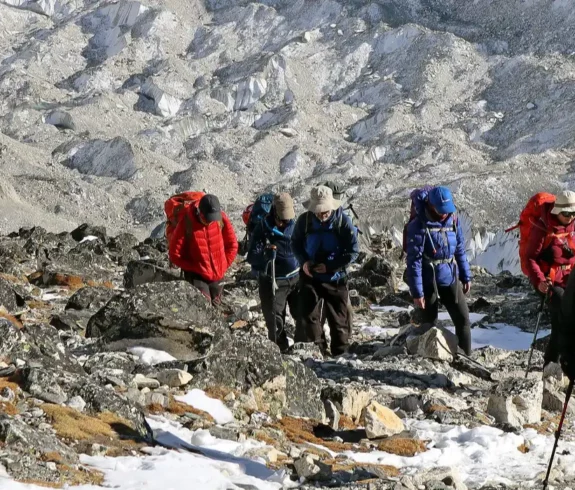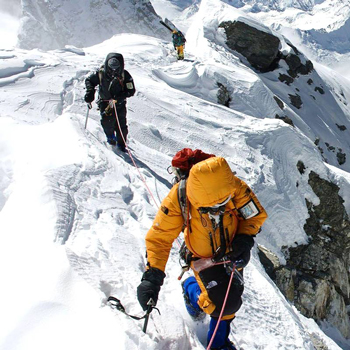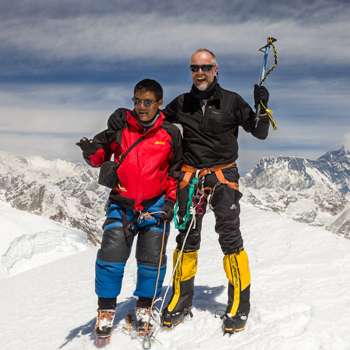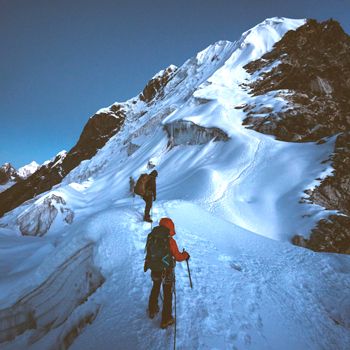Island Peak, reaching 6,189 meters (20,305 feet) in the Khumbu region of Nepal, is an acclaimed trekking peak renowned for its accessibility and moderate climbing difficulty. Because of the Island Peak Climbing Difficulty, both beginners and seasoned climbers can safely conquer the remarkable peak, which provides ample problems but not the unreasonable technical aspect of climbing higher mountains.
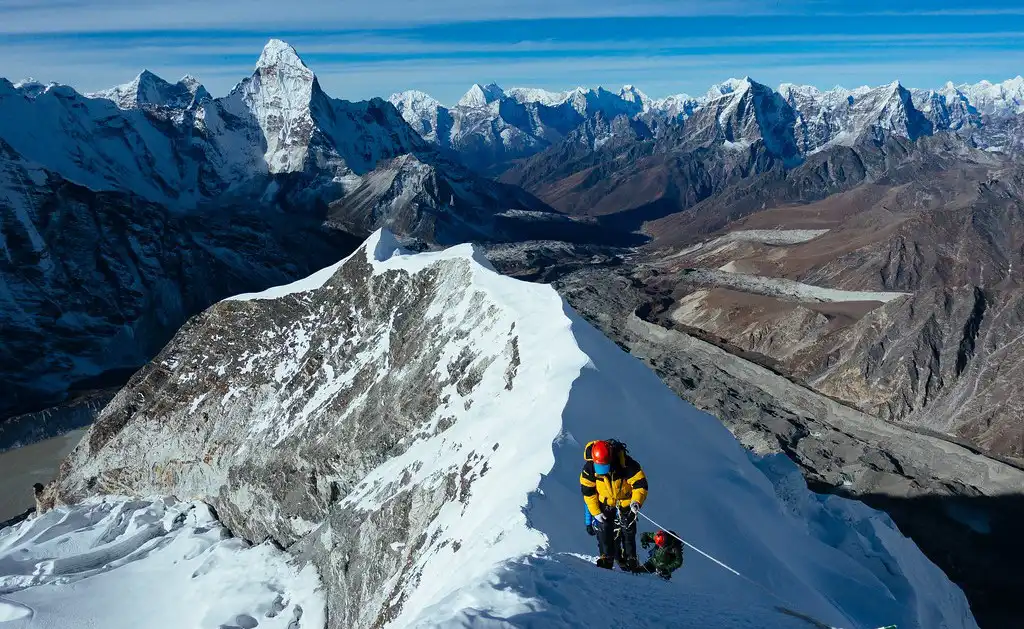
This mountain allows explorers to see mesmerizing views from the summit, which contains gorgeous ranges, including the striking Mount Everest among the other peaks.
Origin of the Name: Island Peak
- Local Name: In the local Sherpa language, Island Peak is known as Imja Tse.
- Historical Naming: The title “Island Peak” was given to it due to its apparent island shape in a frozen sea, which Eric Shipton’s team noticed in 1953. This peculiarity is why Island Peak has become an unmistakable point of interest for climbers worldwide.
- Symbolic Significance: The peak stands as a symbol of beauty and challenge in the heart of the Himalayas, inviting climbers to experience the thrill and fulfillment of summiting a Himalayan peak. Its name reflects its physical isolation and the surreal, moon-like landscape surrounding it at high altitudes.

Overview of Island Peak Climbing Difficulty
Despite its classification as a trekking peak, Island Peak presents significant technical challenges. The Island Peak Climbing Difficulty arises from steep ice slopes, crevassed glaciers, and the need for basic mountaineering skills. Climbers must be prepared for demanding conditions that go beyond regular trekking experiences.
Classification
- Technical Challenges: Island Peak requires proficiency in using crampons, ice axes, and harnesses.
- Steep Ascents: The climb includes a 100-meter (328 feet) ice headwall with slopes up to 45 degrees.
- Glacier Navigation: Traversing crevassed glaciers demands knowledge of rope techniques and safety protocols.
- Altitude Exposure: At 6,189 meters (20,305 feet), climbers face risks associated with high altitude.
Who It’s For
- Experienced Trekkers: Ideal for those with high-altitude trekking experience above 4,000 meters (13,123 feet).
- Aspiring Mountaineers: Suitable for climbers looking to advance to technical climbing.
- Physically Fit Individuals: Requires solid cardiovascular fitness and endurance.
- Skill Builders: This is an excellent opportunity to learn and apply basic mountaineering skills in a real-world setting.

Technical Aspects of Island Peak Climbing Difficulty
Climbing Island Peak involves technical challenges that require specific mountaineering skills. Understanding the “Island Peak Climbing Difficulty” is crucial for anyone planning this adventure.
Equipment Use
Proficiency in using specialized equipment is essential:
- Crampons: Necessary for traversing icy and snowy terrains.
- Ice Axes: These are used for climbing steep slopes and self-arrest in case of a slip.
- Harnesses: Important for safety during roped sections.
- Ropes: Essential for glacier travel and ascending fixed lines.
Familiarity with this equipment enhances safety and efficiency. Prior training with these tools is recommended before attempting the Imja Tse Climb.
Key Sections
The climb includes several challenging sections that contribute to the Island Peak Climbing Difficulty.
1. Glacier Travel
- Crevassed Glaciers: The route crosses glaciers with hidden crevasses.
- Rope Team Travel: Climbers must move in rope teams to ensure safety.
- Crevasse Rescue Knowledge: Essential skills if a team member falls into a crevasse.
- Navigation Skills: Ability to read glacier terrain and choose safe paths.
2. Headwall Climb
- Steep Snow and Ice Headwall: A 100-meter (328-foot) ascent that is physically demanding.
- Fixed Ropes: Climbers use fixed ropes for ascent, requiring skill with ascenders.
- Physical Endurance: This section tests strength and stamina.
- Technical Climbing: Involves steep angles up to 45 degrees.
3. Summit Ridge
- Narrow and Exposed Ridge: Requires careful footing and balance.
- High Altitude: Elevation adds to the difficulty due to thinner air.
- Weather Conditions: Wind and cold can make this section more challenging.
- Mental Focus: Essential for navigating the exposed terrain safely.
Physical Fitness Requirements
Conquering the Island Peak Climbing Difficulty demands a high level of physical fitness. Climbers must prepare their bodies to handle steep ascents, high altitudes, and the physical strain of carrying gear.
Endurance Training
- Cardiovascular Workouts: Engage in running, cycling, or swimming to build stamina.
- Regular Sessions: Aim for at least four to five weekly cardio sessions.
- Long Duration: Each session should last 45 minutes to an hour.
- Gradual Increase: Slowly increase the intensity to improve endurance for the Island Peak Expedition.
Strength Training
- Leg Strength: Focus on exercises such as squats, lunges, and step-ups to tackle steep climbs.
- Core Stability: Incorporate planks and sit-ups to enhance balance and support.
- Upper Body Strength: Use push-ups and pull-ups to manage climbing equipment effectively.
- Weighted Practice: Train by hiking with a backpack to simulate carrying gear during the Island Peak Trekking.
Altitude Preparedness
- High-Altitude Experience: Gain prior experience by trekking above 4,000 meters (13,123 feet).
- Acclimatization: Understand how your body reacts to thinner air to reduce the risk of altitude sickness.
- Breathing Techniques: Practice controlled breathing to maximize oxygen intake.
- Awareness of Symptoms: Learn the signs of altitude sickness that are common on climbs like Island Peak Nepal.
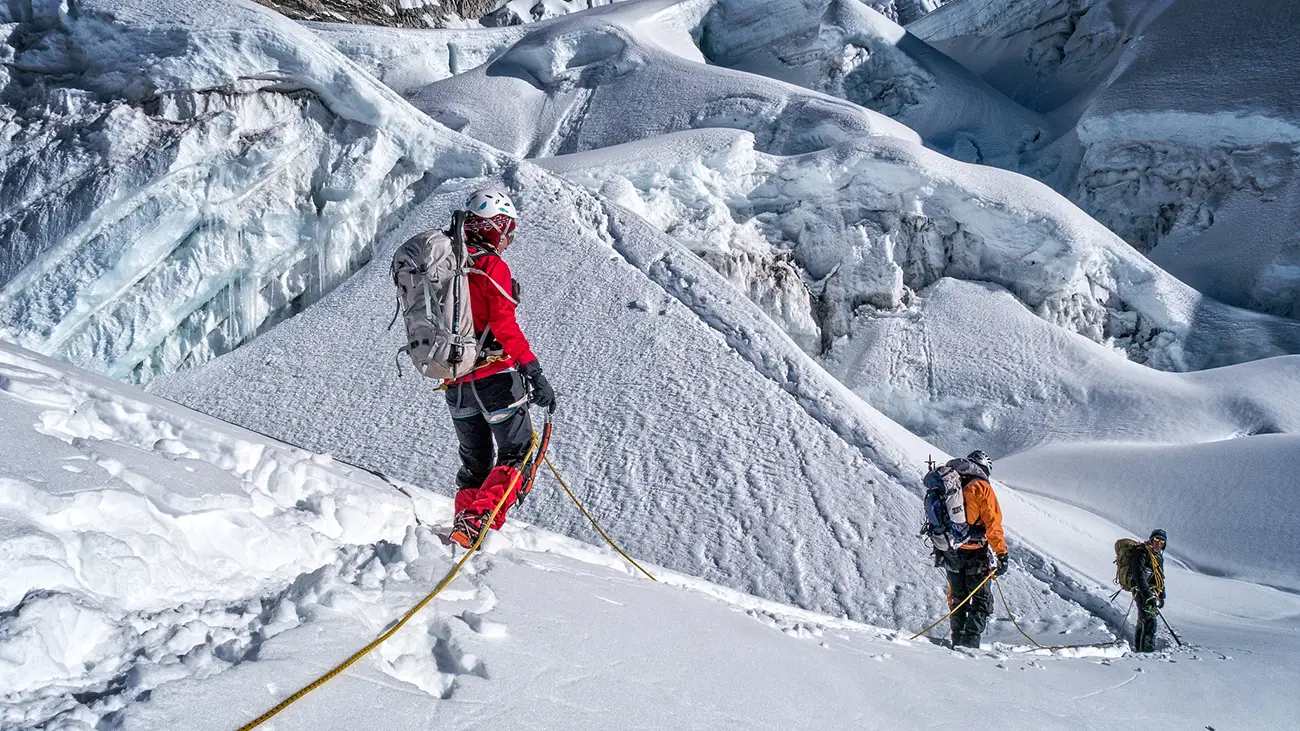
Altitude and Acclimatization
Understanding altitude and acclimatization is crucial when considering the Island Peak Climbing Difficulty. The high elevations encountered during the ascent pose significant challenges that require careful preparation and awareness.
Acute Mountain Sickness (AMS)
Acute Mountain Sickness (AMS) is a common risk when climbing high altitudes like those on Island Peak Nepal. It is essential for safety to recognize and address AMS promptly.
Symptoms of AMS
- Headache
- Nausea and vomiting
- Dizziness or light-headedness
- Fatigue or weakness
- Shortness of breath during exertion
Prevention Strategies
- Gradual Ascent: Increase elevation slowly to allow the body to adjust.
- Medication: Consider prophylactic medicines like acetazolamide after consulting a healthcare professional.
- Avoid Alcohol and Sedatives: These can exacerbate symptoms.
- Listen to Your Body: Do not ignore symptoms; if they worsen, descend immediately.
Acclimatization Schedule
A well-planned acclimatization schedule can significantly reduce the risks associated with high altitude, making the Island Peak Expedition more attainable.
- Incorporate Rest Days: Plan rest days into your itinerary to allow your body to adapt.
- Gradual Ascent Profiles: Limit daily altitude gains to 300-500 meters (984-1,640 feet) above 3,000 meters (9,843 feet).
- Pre-Climb Trekking: Many climbers first trek to Everest Base Camp before Climbing Island Peak to aid acclimatization.
Sample Itinerary
- Day 1-2: Trek from Lukla to Namche Bazaar (acclimatization day included)
- Day 3-5: Trek to Dingboche with rest days
- Day 6-7: Move to Island Peak Base Camp with acclimatization hikes
Hydration and Nutrition
Acclimatization and performance on the mountain largely depend on the intake of fluids and food.
Hydration
- Drink Ample Fluids: Aim for at least 3-4 liters of water daily.
- Avoid Dehydrating Substances: Reduce your consumption of caffeine and alcohol.
- Monitor Urine Color: Clear urine indicates good hydration levels.
Nutrition
- Balanced Diet: Focus on carbohydrates for energy and proteins for muscle repair.
- Regular Meals: Eat frequent, small meals to maintain energy levels.
- Include Iron-Rich Foods: Helps in oxygen transport and is beneficial at high altitudes.
Training and Preparation
Adequate training and preparation are vital to overcoming the Island Peak Climbing Difficulty. This peak requires physical strength, technical skills, and mental fortitude.
Mountaineering Courses
Participating in mountaineering courses is highly recommended before attempting the Island Peak Expedition.
- Glacier Travel: Learn how to navigate crevassed glaciers safely. Courses cover techniques for detecting crevasses and choosing secure routes.
- Ice Climbing: Gain proficiency in climbing steep ice walls using ice axes and crampons. This skill is essential for the headwall section when Climbing Island Peak.
- Crevasse Rescue: Acquire knowledge in rescue techniques to assist team members in case of a crevasse fall.
These courses equip you with the necessary skills to handle the technical aspects of the climb confidently.
Fitness Regimen
A targeted fitness regimen over at least 4-6 months is crucial to meet the physical demands of the Island Peak Difficulty Level.
- Cardiovascular Workouts: Engage in running, cycling, or swimming to build endurance.
- Strength Training: Focus on leg exercises like squats and lunges to tackle steep ascents. Strengthen your core for better balance and stability.
- Altitude Training: Train at higher elevations to acclimate your body to lower oxygen levels.
Consistent physical preparation enhances performance and reduces the risk of injury during the Island Peak Trekking experience.
Mental Preparation
Mental stamina is on par with physique regarding the Island Peak Nepal challenges.
- Coping with Altitude Stress: Practice breathing techniques and meditation to manage stress and anxiety at high altitudes.
- Visualization Techniques: Visualize each climb stage to prepare mentally for difficult sections like the headwall and summit ridge.
- Stress Management: Create techniques that help cope with distressing situations while maintaining composure and concentration.
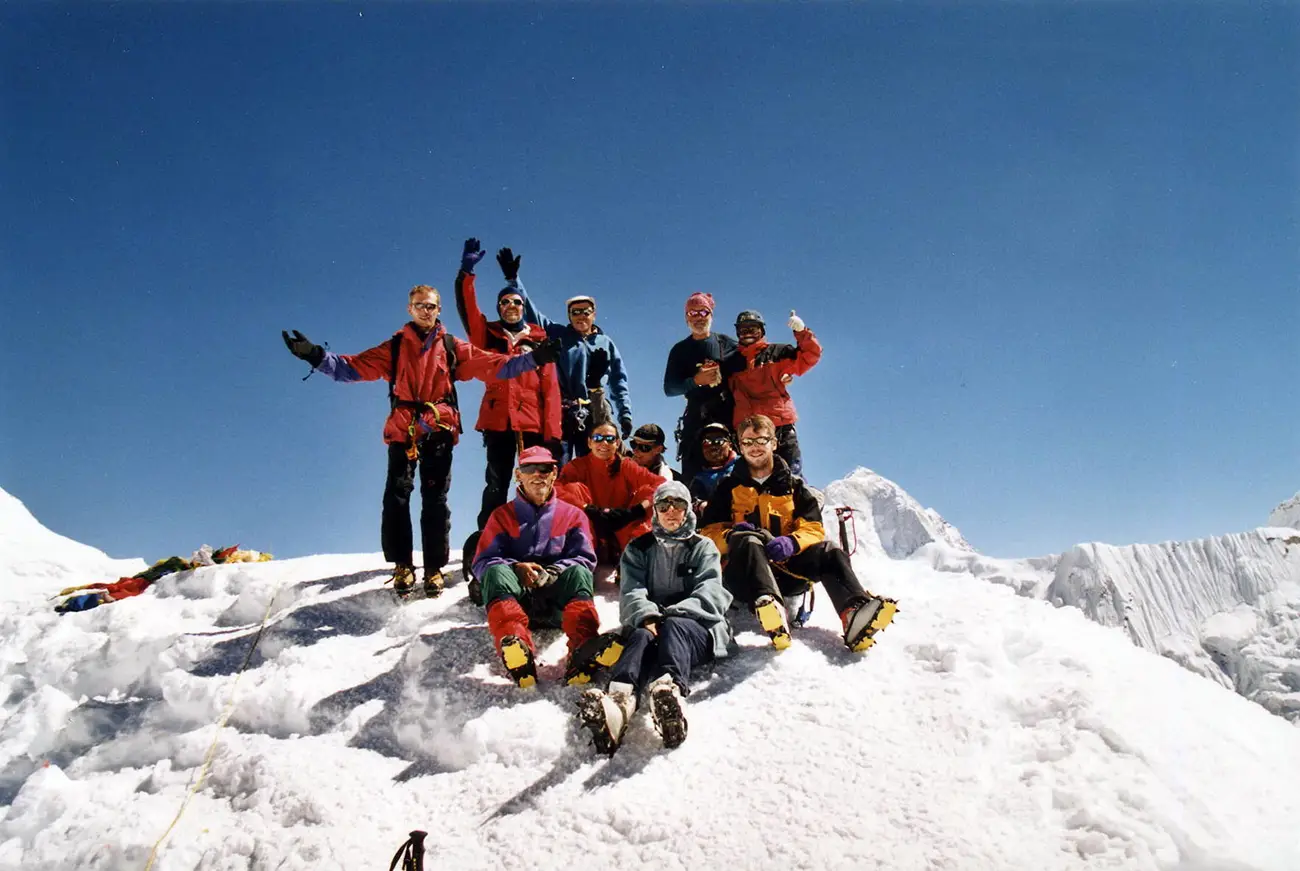
Best Time to Climb Island Peak
Choosing the right climbing time is crucial for managing the Island Peak Climbing Difficulty. Optimal seasons offer favorable weather conditions, enhancing safety and the overall climbing experience. Understanding the best times and weather patterns can significantly impact your success on Island Peak Nepal.
Pre-Monsoon Season: March to May
The pre-monsoon season, from March to May, is one of the most popular times to climb Island Peak. This period offers several advantages:
- Stable Weather: The weather is usually stable, with few or no storms causing sudden weather changes.
- Moderate Temperatures: Daytime temperatures are comfortable, while nights are cold but manageable with proper gear.
- Clear Views: The melting snow leads to clearer skies, providing stunning panoramic views of the Himalayas, including Everest.
- Floral Blooms: The trails are vibrant with blooming rhododendrons, adding to the scenic beauty of the trek.
Tips for Pre-Monsoon Climbing
- Book Early: This season is highly sought after, so secure permits and guides skillfully in advance.
- Prepare for Crowds: Expect more trail climbers; patience and following your guide are essential.
- Layer Your Clothing: Conditions will change, hence the need to dress in layers for temperature changes, which will more often than not occur within the day.
Post-Monsoon Season: September to November
The post-monsoon season, from September to November, is another excellent time to tackle Island Peak Climbing Difficulty. This period is favored for its distinct advantages:
- Clear Skies: After the monsoon rains, the skies clear up, offering unparalleled visibility and breathtaking views.
- Stable Conditions: Weather conditions are generally stable, with less precipitation and lower humidity.
- Optimal Temperatures: Similar to the pre-monsoon season, moderate temperatures make climbing more comfortable.
- Less Crowded: While popular, this season tends to have fewer climbers compared to the pre-monsoon period, allowing for a more serene experience.
Tips for Post-Monsoon Climbing
- Check Weather Forecasts: Although conditions are generally stable, stay updated with local weather forecasts.
- Prepare for Cooler Nights: Nights can be colder, so ensure you have appropriate sleeping gear.
- Take Advantage of Clear Days: Utilize clear weather for acclimatization hikes and rest days to enjoy the mountain scenery fully.
Weather Considerations
Understanding seasonal weather patterns is essential for planning your Island Peak Expedition. Here are key weather factors to consider:
- Wind Speed and Direction: High winds can increase climbing difficulty and safety risks. Plan climbs during periods of lower wind activity.
- Precipitation Levels: Avoid climbing during the monsoon season (June to August), when heavy rains and landslides can occur, increasing the Island Peak Difficulty Level.
- Temperature Fluctuations: Be prepared for significant temperature changes daily and night. Proper gear and clothing layers are vital for comfort and safety.
- Snow Conditions: The stability of snow and ice can vary with seasons. Pre-monsoon offers firmer snow, while post-monsoon may have more settled ice, affecting the climbing strategy.
Equipment and Gear: Managing Island Peak Climbing Difficulty
Proper equipment and gear are fundamental when tackling the Island Peak Climbing Difficulty. The right choices enhance your safety and increase the likelihood of a successful climb. Here’s a comprehensive guide to help you prepare effectively.
Essential Gear List
For a successful ascent of Island Peak, you’ll need the following essential items:
- Boots: Sturdy, insulated mountaineering boots are crucial for warmth and support.
- Crampons: Fit to your shoes for enhanced grip on ice and snow.
- Ice Axe: Essential for navigating icy slopes and aiding in self-arrest.
- Harness: Necessary for roped climbing and securing fixed lines.
- Helmet: Protects against falling debris and accidental impacts.
- Climbing Ropes: Vital for safety on steep ice and snow sections.
- Appropriate Clothing Layers: Include thermal base layers, an insulating layer, and a waterproof outer layer.
Rental vs. Ownership
Deciding whether to rent equipment in Nepal or bring your gear is crucial and can impact your climb.
Pros of Renting Equipment
- Cost-Effective: Renting can be cheaper, primarily if you do not regularly engage in mountaineering.
- Convenience: Avoids the hassle of carrying heavy gear internationally.
- Local Varieties: Rental gear in Nepal is often suited to the local climbing conditions.
Cons of Renting Equipment
- Fit and Comfort: Rental gear and personal equipment may not fit.
- Availability: Popular sizes and items may be out of stock during peak seasons.
- Wear and Tear: Rented gear may be worn and less reliable.
Pros of Owning Equipment
- Custom Fit: Gear tailored to your specific needs and size.
- Familiarity: Using your accustomed gear can improve performance and comfort.
- Long-Term Investment: Cost-effective if you plan to climb regularly.
Cons of Owning Equipment
- Initial Cost: A high upfront investment is required.
- Travel Inconvenience: Carrying gear can be cumbersome when done internationally.
Packing Tips
Adequate packing is crucial for managing your load and ensuring you have all necessary items without overburdening yourself.
Weight Management: Balance the weight evenly in your backpack. Keep heavier items close to your back and higher up for better weight distribution.
Essential vs. Non-Essential Items:
- Essential: Safety gear, navigation tools, first aid supplies, and proper clothing.
- Non-Essential: Avoid items that are not directly useful or provide comfort, such as excessive gadgets or luxury items.
Checklists: Create a packing list to ensure you remember critical gear.
Review and Reduce: After packing, review your items and remove anything that is not necessary.
Navigating the Island Peak Climbing Difficulty: Route Details and Itinerary
Tackling the Island Peak Climbing Difficulty requires a comprehensive understanding of the route, camp setups, and a well-planned itinerary. Here’s a detailed guide to help climbers prepare for their adventure through some of the most iconic trekking paths in the Himalayas.
Standard Route
The trek to Island Peak starts from Lukla, a small town serving as the Everest region’s gateway. From Lukla, climbers follow a well-trodden path:
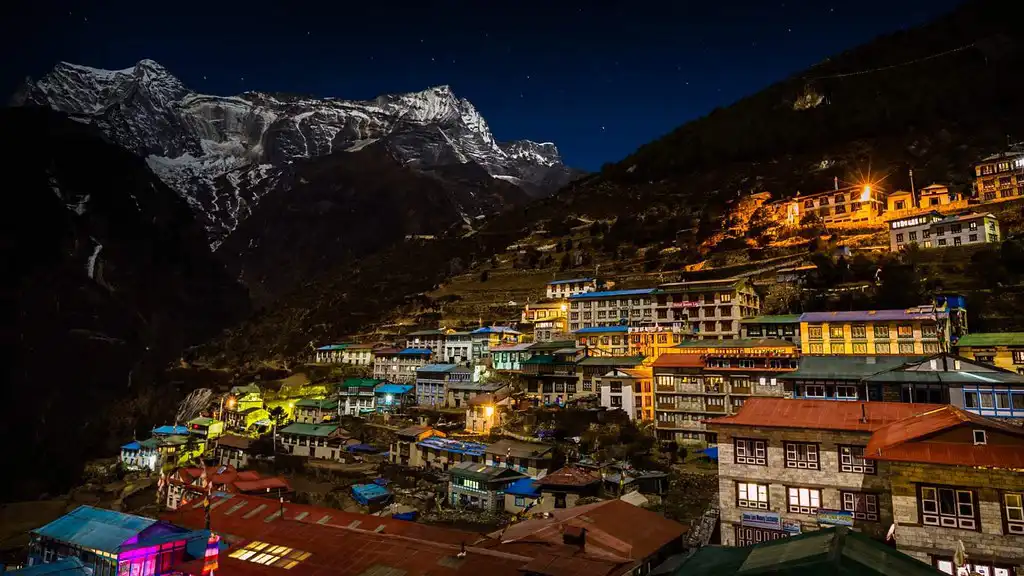
Commonly known as the ‘Gateway to the High Himalayas,’ Namche is an essential acclimatization stop, offering a vibrant Sherpa culture and various amenities.
Tengboche: Known for its monastery, Tengboche is a spiritual center with stunning views of Everest, Ama Dablam, and other Himalayan giants.

Dingboche is another key acclimatization spot, offering climbers opportunities to adapt to the altitude while enjoying breathtaking scenery.
Chukhung: The last stop before reaching the base camp, Chukhung is an essential staging area to prepare for the ascent of Island Peak.
Camp Setup
- Base Camp (5,087 meters/16,690 feet): Island Peak Base Camp is nestled in a stunning location, surrounded by the imposing south face of Lhotse and the sweeping Imja glaciers. It serves as the primary hub for climbers, providing a communal area for final preparations before the climb.
- Optional High Camp (5,600 meters/18,373 feet): Establishing a high camp can benefit those who prefer a shorter summit day. High Camp offers a more direct route to the summit, albeit with more basic facilities than Base Camp.
Itinerary Overview
A typical expedition to Island Peak spans 15-20 days, depending on the chosen route and the climber’s preference for acclimatization:
Day 1-3: Arrive in Kathmandu, fly to Lukla, then trek to Phakding.
Day 4-5: Reach Namche Bazaar and spend a day acclimatizing, which might include short hikes to nearby attractions.
Day 6-8: Trek to Tengboche, then Dingboche, with another acclimatization day.
Day 9-10: Move to Chukhung, conduct final preparations, and acclimatize further.
Day 11-13: Trek to Island Peak Base Camp and establish High Camp.
Day 14-15: Summit Day, starting early morning for the ascent and returning to Base Camp.
Day 16-20: Return trek to Lukla via the same route, with flights back to Kathmandu on the final day.
Challenges and Risks: Navigating the Island Peak Climbing Difficulty
Addressing the Island Peak Climbing Difficulty involves acknowledging the challenges and risks associated with this high-altitude adventure. Here’s an essential guide that outlines common difficulties, safety measures, and rescue services available during the climb.
Common Difficulties
Climbing Island Peak presents several challenges that climbers must prepare for:
- Altitude Sickness: The most prevalent issue climbers face is altitude sickness, caused by the rapid ascent and the body’s inability to adjust quickly enough to decrease oxygen levels.
- Harsh Weather Conditions: Weather in the Himalayas can change rapidly, presenting climbers with severe cold, wind, snow, and sudden storms.
- Physical Exhaustion: The strenuous nature of the climb can lead to fatigue, which is compounded by altitude and weather conditions.
Safety Measures
Implementing effective safety measures is crucial to managing the Island’s Peak Climbing Difficulty:
- Follow Guide Instructions: Always adhere to the guidance and decisions of your experienced guides. They understand local conditions and can make critical safety decisions.
- Regular Health Checks: Check your health regularly throughout the climb. Early detection of symptoms related to altitude sickness or exhaustion can prevent complications.
- Emergency Protocols: You should know your group’s emergency plan if any problems arise, especially accidents. Where possible, find out the closest hospital and how to get emergency assistance, if necessary.
Rescue Services
Understanding the availability and details of rescue services is critical:
- Helicopter Evacuation: Most climbing tours, managed by experienced providers like Peregrine Treks and Tours, offer helicopter evacuation options in serious emergencies. This service can be a lifeline in critical health situations.
- Insurance Requirements: Ensure you have appropriate travel and medical insurance that covers high-altitude trekking and helicopter evacuation. Check the specifics of your policy to confirm that it meets the needs of climbing Island Peak.

Island Peak Climbing Difficulty: A Comparative Look at Himalayan Peaks
Understanding the Island Peak Climbing Difficulty in the context of other Himalayan peaks can help climbers gauge their readiness and plan their mountaineering progression effectively. Here’s how Island Peak compares to famous climbs like Mera Peak and Lobuche East and how it can prepare climbers for even more formidable challenges.
Mera Peak vs. Island Peak
Mera Peak
- Altitude: Mera Peak is taller at 6,476 meters (21,247 feet), climbing higher than Island Peak.
- Technical Challenge: Though higher, Mera Peak is considered less technical, with fewer steep climbs and technical sections, making it more accessible for those with essential high-altitude trekking experience.
Island Peak
- Altitude: At 6,189 meters (20,305 feet), it is slightly lower than Mera Peak.
- Technical Challenge: Island Peak presents more technical challenges, including steep ice and snow climbs, fixed ropes, and a demanding summit ridge that requires intermediate mountaineering skills.
Comparison Insight: Climbing Island Peak offers a more challenging technical experience, making it ideal for climbers who want to improve their skills in preparation for more challenging ascents.
Lobuche East: A Technical Comparison
Lobuche East
- Known for its more technical routes, Lobuche East exceeds the Island Peak Climbing Difficulty in several aspects. It features steeper sections of rock and ice, requiring advanced technical skills and proficiency in using climbing equipment.
Island Peak
- While technically demanding, Island Peak is often used as a preparatory climb for those aiming to tackle peaks like Lobuche East, which require more complex skills.
Comparison Insight: Climbers often ascend Island Peak as a stepping stone to acclimate and refine their skills before attempting Lobuche East, which demands higher technical expertise.
Progression Path: From Island Peak to Higher Peaks
Climbing Island Peak is an excellent preparation for tackling higher and more technically challenging mountains. Here’s how it can prepare climbers:
- Skill Development: The climb involves technical maneuvers and advanced mountaineering gear, laying a solid foundation for more challenging ascents.
- Confidence Building: Successfully navigating the Island Peak Climbing Difficulty boosts climbers’ confidence, which is crucial for taking on more significant challenges.
- Acclimatization: Climbing to 6,189 meters helps the body acclimate to high altitudes, preparing climbers for the thin air conditions on peaks like Ama Dablam or Mount Everest.
Progression to Higher Peaks
- Ama Dablam: Known for its stunning aesthetics and challenging climbs, transitioning from Island Peak to Ama Dablam requires significant technical ability and experience.
- Mount Everest: Climbing Everest is a colossal challenge requiring extensive high-altitude experience. Island Peak serves as a preliminary high-altitude experience, familiarizing climbers with the rigors of prolonged expeditions in extreme conditions.
Conclusion: Conquering Island Peak Climbing Difficulty
Successfully navigating the Island Peak Climbing Difficulty requires careful preparation, thorough training, and a deep respect for the mountain. The climb presents physical and technical challenges, making it essential to focus on acclimatization, fitness, and equipment knowledge before attempting the ascent.
By dedicating time to building the necessary skills and understanding the mountain’s terrain, climbers can face these challenges more confidently. Island Peak offers a fulfilling and rewarding experience that tests your abilities and provides immense personal growth. The sense of accomplishment after reaching the summit is unmatched, leaving climbers with unforgettable memories and invaluable lessons in perseverance.
If you’re an aspiring mountaineer seeking to advance your skills, now is the time to start preparing. Island Peak is an excellent stepping stone to higher and more technical peaks, offering a perfect blend of challenge and achievement. Start your training today, and consider Island Peak as a critical milestone in your climbing progression.
